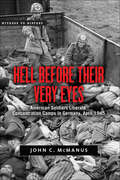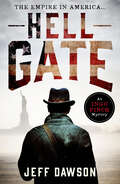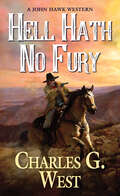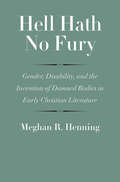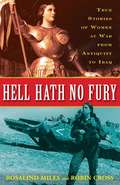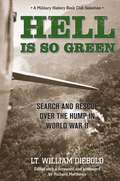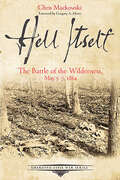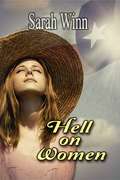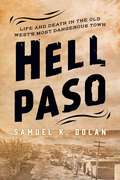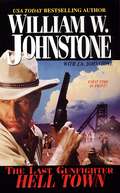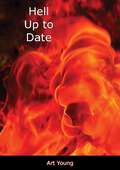- Table View
- List View
Hell Before Breakfast: America's First War Correspondents Making History and Headlines, from the Battlefields of the Civil War to the Far Reaches of the Ottoman Empire
by Robert H. PattonThe first "war correspondent," William H. Russell of The Times of London, described himself and his profession as "the miserable parent of a luckless tribe." Others saw it differently: the war correspondent became the stuff of dreams and an urgent romantic calling. . . . Now, Robert H. Patton, acclaimed historian, author of The Pattons ("Exceptional"--The Washington Post; "Truly remarkable"--John S. Eisenhower) and Patriot Pirates ("Soul-stirring--as good as reading a Patrick O'Brian novel, except that every word is true"--Michael Korda), rediscovers and celebrates, in Hell Before Breakfast, America's first war correspondents, forgotten today but legends in their time. Here are the men who, between 1850 and 1914, and particularly during America's Civil War and the Spanish-American War, led the most romantic and thrilling of lives on the edgiest frontiers of time and space, where empires fell and dynasties flourished; they were correspondents who saw the world, broke the story, were making the news during the years when newspapers made available the most foreign of landscapes and their circulation wars were revolutionizing contemporary life, shaping global events, and creating history. Patton writes of the decades of lightning progress and high adventure, when America was emerging as a great power and the monarchies of Europe battled for dominance through a series of brief, bloody imperial wars; when the newly discovered electric telegraph enabled these extraordinary first-person dispatches to be splashed across the daily newspapers then proliferating on both sides of the Atlantic. Through the eyes (and minds) of American adventurers, soldiers, and artists-turned-correspondents--Mark Twain and the painter John Millet among them--we see what they saw and what they brought to life: the Civil War, the Austro-Prussian War, the Franco-Prussian War, the Russo-Turkish War. Patton writes about New York Herald reporter Henry Stanley, who led a caravan from the Tanzanian coast into the uncharted "cannibal country" and, after a 236-day trek, discovered the long lost and presumed dead Dr. David Livingstone . . . about Archibald Forbes of the London Daily News bringing to life in his dispatches the frantic assembly of barricades along Paris streets as royalists and Communists fought with bayonets following the Prussian invasion. Here are the fearless young correspondents, among them Henry Villard of Bavaria, a journalist who covered the Civil War and ended up a financial titan, head of the Northern Pacific Railway and an early investor in the company that would ultimately become General Electric; and George Smalley, chief war correspondent of the New York Tribune, who watched for twenty-four hours as the Union Army of the Potomac and the Confederate Army of Northern Virginia fought in the cornfields and woodlands around Antietam Creek. These correspondents were at center stage and, through their on-the-spot reporting, became legends in their time. Their intrepid spirit and sense of adventure inspired generations of storytellers, explorers, artists, writers, statesmen and politicians, and even moviemakers--from Rudyard Kipling and Winston Churchill to Theodore Roosevelt, D. W. Griffith, and Cecil B. DeMille--men whose adolescence was shaped during this spectacular age of war correspondence.From the Hardcover edition.
Hell Before Their Very Eyes: American Soldiers Liberate Concentration Camps in Germany, April 1945 (Witness to History)
by John C. McManusThe life-altering experiences of the American soldiers who liberated three Nazi concentration camps.On April 4, 1945, United States Army units from the 89th Infantry Division and the 4th Armored Division seized Ohrdruf, the first of many Nazi concentration camps to be liberated in Germany. In the weeks that followed, as more camps were discovered, thousands of soldiers came face to face with the monstrous reality of Hitler’s Germany. These men discovered the very depths of human-imposed cruelty and depravity: railroad cars stacked with emaciated, lifeless bodies; ovens full of incinerated human remains; warehouses filled with stolen shoes, clothes, luggage, and even eyeglasses; prison yards littered with implements of torture and dead bodies; and—perhaps most disturbing of all—the half-dead survivors of the camps. For the American soldiers of all ranks who witnessed such powerful evidence of Nazi crimes, the experience was life altering. Almost all were haunted for the rest of their lives by what they had seen, horrified that humans from ostensibly civilized societies were capable of such crimes. Military historian John C. McManus sheds new light on this often-overlooked aspect of the Holocaust. Drawing on a rich blend of archival sources and thousands of firsthand accounts—including unit journals, interviews, oral histories, memoirs, diaries, letters, and published recollections—Hell Before Their Very Eyes focuses on the experiences of the soldiers who liberated Ohrdruf, Buchenwald, and Dachau and their determination to bear witness to this horrific history.
Hell Creek, Montana: America's Key to the Prehistoric Past
by Lowell Dingus"Given its wide range, this book should attract readers of history and lovers of the American West in addition to dinosaur junkies. " - Publishers WeeklyHell Creek, Montana, is one of the most windswept, hardscrabble locales in the American West-a quiet town of ranchers, farmers, and others who seek the beauty of the open spaces. It is also the unlikely setting of some of the most fascinating events in the history of the United States and North America. From the first-ever discovery of a Tyrannosaurus rex to Lewis and Clark's landmark expedition; from the Freeman compound standoff to Sitting Bull and Little Big Horn, Hell Creek has been a central player in the events of the last two hundred years-and the last 200 million.Now, with grace and quiet wit, renowned paleontologist and writer Lowell Dingus takes us on a tour of this desolate, beautiful, out-of-the-way place and illuminates its inhabitants, geology, paleontology, and surprising place in history. Nature lovers, dinosaur buffs, and people fascinated with the turbulent history--both ancient and modern--of the American West will find much to delight them in this journey to Hell Creek.
Hell From the Heavens: The Epic Story of the USS Laffey and World War II's Greatest Kamikaze Attack
by WukovitsOn the morning of April 16, 1945, the crewmen of the USS Laffey saw what seemed to be the entire Japanese air force assembled directly above. They were about to become the targets of the largest single-ship kamikaze attack of World War II. By the time the unprecedented assault was finished, thirty-two sailors were dead and more than seventy wounded. Although she lay shrouded in smoke and fire for hours, the Laffey somehow survived. The gutted American warship limped from Okinawa’s shore for home, where the ship and crew would be feted as heroes. Using personal interviews with survivors, the memoirs of crew members, and their wartime correspondence, John Wukovits breathes life into the story of this forgotten historic event.
Hell Gate (An Ingo Finch Mystery)
by Jeff DawsonTo solve this case, only an outsider will do… Ingo Finch faces his biggest challenge yet.New York, 1904 – over a thousand are dead after the sinking of the General Slocum, a pleasure steamer full of German immigrants out for a day on the East River. The community is devastated, broken, in uproar.With a populist senator preying on their grievances, a new political force is unleashed, pushing America to ally with Germany in any coming war.Nine months later, Ingo Finch arrives in Manhattan, now an official British agent. Tasked with exposing this new movement, he is caught in a deadly game between Whitehall, Washington, Berlin… and the Mob.Not everything in the Big Apple is as it seems. For Finch, completing the mission is one thing; surviving it quite another…An unputdownable story of anarchists, Feds, gangs and Gilded Age mystery, the third thrilling instalment of the Ingo Finch crime series is perfect for fans of Abir Mukherjee, Philip Kerr and C J Sansom.Praise for Hell Gate'Riveting and beautifully written' Alex Gerlis, author of the Richard Prince Thrillers'A well-written and compelling thriller ... The pace never lets up. A very strong spy story' Sarah Ward, author of the DC Childs Mysteries'A fantastic writer' Making the Cut podcast
Hell Gate: A Nexus of New York City’s East River (Excelsior Editions)
by Michael NicholsPart history and part memoir, Hell Gate tells of a man's excursions along and through Hell Gate, a narrow stretch of water in New York City's East River, notorious for dangerous currents, shipwrecks, and its melancholic islands and rocks. Drawn to the area by his fascination with its name—from the Dutch Hellegat, translated into English as both "bright passage" and "hellhole"—what begins as a set of casual walks for Michael Nichols becomes an exploration of landscape and history as he traces these idyllic and hellish images in an attempt to discover Hell Gate's hidden character and the meaning of its elusive name. Using a loosely constructed set of sketches organized as a kind of tour along the edge of the river and then from a rowboat in the river, Nichols describes scenes and events as they present themselves, mixing history and lore with contemporary scenes.
Hell Hath No Fury (A John Hawk Western #1)
by Charles G. WestIn this action-packed, Spur Award–winning western series opener, an army scout must find two lost newlyweds in a land where he&’s as good as dead. To start their new life together, Jamie Pratt and his young bride join a westward wagon train bound for the Rocky Mountains. They get as far as Helena when their unscrupulous wagon master deserts them, leaving them as good as dead in a godforsaken, blood-scorched land. The other settlers agree to set stakes where they are, but Jamie and his wife press on toward the Bitterroot Valley, deep into Sioux territory.They never come out the other side. Jamie&’s brother, Monroe, enlists the legendary scout John Hawk to find them. A hardened veteran of the range, Hawk is living off the land in a little cabin on the Boulder River when Monroe comes begging for his help. To rescue the Pratts, Hawk—and his guns—will soon be back in the saddle, riding fast and fierce into deadly odds. For any other man it&’s a suicide mission. But for Hawk, it&’s what he was made for . . .Winner of the 2018 Spur Award for Best Paperback Western
Hell Hath No Fury: Gender, Disability, and the Invention of Damned Bodies in Early Christian Literature (The Anchor Yale Bible Reference Library)
by Meghan R. HenningThe first major book to examine ancient Christian literature on hell through the lenses of gender and disability studies Throughout the Christian tradition, descriptions of hell&’s fiery torments have shaped contemporary notions of the afterlife, divine justice, and physical suffering. But rarely do we consider the roots of such conceptions, which originate in a group of understudied ancient texts: the early Christian apocalypses. In this pioneering study, Meghan Henning illuminates how the bodies that populate hell in early Christian literature—largely those of women, enslaved persons, and individuals with disabilities—are punished after death in spaces that mirror real carceral spaces, effectually criminalizing those bodies on earth. Contextualizing the apocalypses alongside ancient medical texts, inscriptions, philosophy, and patristic writings, this book demonstrates the ways that Christian depictions of hell intensified and preserved ancient notions of gender and bodily normativity that continue to inform Christian identity.
Hell Hath No Fury: True Stories of Women at War from Antiquity to Iraq
by Rosalind Miles Robin CrossAn engaging collection that uncovers injustices in history and overturns misconceptions about the role of women in war. When you think of war, you think of men, right? Not so fast. In Hell Hath No Fury, Rosalind Miles and Robin Cross prove that although many of their stories have been erased or forgotten, women have played an integral role in wars throughout history. In witty and compelling biographical essays categorized and alphabetized for easy reference, Miles and Cross introduce us to war leaders ...
Hell In A Very Small Place: The Siege Of Dien Bien Phu
by Bernard B. FallThe 1954 battle of Dien Bien Phu ranks with Stalingrad and Tet for what it ended (imperial ambitions), what it foretold (American involvement), and what it symbolized: A guerrilla force of Viet Minh destroyed a technologically superior French army, convincing the Viet Minh that similar tactics might prevail in battle with the U. S.
Hell Is So Green: Search and Rescue over the Hump in World War II
by William DieboldLt. William Diebold served in the Army&’s Air Transport Command in the China-Burma-India theater of World War II and never fired a weapon in battle. Like many men who flew the Hump, he never saw on-the-ground combat, but he fought bravely by saving lives. Flyers who crossed the eastern Himalayas to keep the allied armies in China supplied with food, fuel, and weapons against Japan—preventing it from concentrating its power in the Pacific—often flew in zero-visibility, sometimes crashing into mountains or falling from the sky from Japanese Zero attacks. Those pilots who survived, Bill Diebold rescued. In Hell Is So Green, Diebold vividly describes the heat and stink of the jungle; the vermin, lice, and leeches; the towering mountains and roaring rivers. Rich with war slang, wisecracks, and old-fashioned phrases, his story reverberates with authenticity and represents the stories of many men that have never been told. After the author&’s early death, the manuscript was put away in an attic—until now. Here, from the shadows of that attic, comes a compelling story of courage under fire and heroism for the ages.
Hell Itself: The Battle of the Wilderness, May 5-7, 1864 (Emerging Civil War Series)
by Chris MackowskiA Civil War historian recounts the first battle between Ulysses S. Grant and Robert E. Lee—a bloody and horrifying conflict in the Wilderness of Virginia.Known simply as the Wilderness, soldiers called the seventy square miles of dense Virginian forest one of the “waste places of nature” and “a region of gloom.” Yet here, in the spring of 1864, the Civil War escalated to a new level of horror.Ulysses S. Grant, commanding all Federal armies, opened the Overland Campaign with a vow to never turn back. Robert E. Lee, commanding the Confederate Army of Northern Virginia, moved into the Wilderness to block Grant’s advance. Thick underbrush made for difficult movement and low visibility. And these challenges were terrifyingly compounded by the outbreak of fires that burned casualties and left both sided blinded in a sea of smoke.Driven by desperation, duty, confusion, and fire, soldiers on both sides marveled that anyone might make it out alive. “This, viewed as a battleground, was simply infernal,” a Union soldier later said. Another called it “Hell itself.”
Hell No: The Forgotten Power of the Vietnam Peace Movement
by Tom HaydenWhy those who protested the Vietnam War must be honored, remembered, and appreciated "Hell no" was the battle cry of the largest peace movement in American history--the effort to end the Vietnam War, which included thousands of veterans. The movement was divided among radicals, revolutionaries, sectarians, moderates, and militants, which legions of paid FBI informants and government provocateurs tried to destroy. Despite these obstacles millions marched, resisted the draft on campuses, and forced two sitting presidents from office. This movement was a watershed in our history, yet today it is in danger of being forgotten, condemned by its critics for everything from cowardice to stab-in-the-back betrayal. In this indispensable essay, Tom Hayden, a principal anti-Vietnam War organizer, calls to account elites who want to forget the Vietnam peace movement and excoriates those who trivialize its impact, engage in caricature of protesters and question their patriotism. In so doing, he seeks both a reckoning and a healing of national memory.
Hell No: Your Right to Dissent in 21st-century America
by Michael Ratner Margaret Ratner KunstlerRatner (attorney, Center for Constitutional Rights) and Kunstler (an attorney currently in private practice), describe the current repression of valid dissent in the United States. They also offer specific instructions for activists to use when confronted with FBI questioning or surveillance. The book closes with a reproduction of the Attorney General's Guidelines for Domestic FBI Investigations, currently know as the Mukasey guidelines, which were issued in 2008 in the last days of the Bush administration, giving the Federal Bureau of Investigation even more power than the previous Ashcroft guidelines, implemented after the attacks of 9/11. The book contains limited footnotes and no index. Annotation ©2011 Book News, Inc., Portland, OR (booknews.com)
Hell On Women
by Sarah WinnIn the aftermath of the Civil War, Annabel Rawlins, a Louisiana belle, agrees to marry Travis Kinlaw, a Texas rancher, in order to become the mistress of her own home. She is unprepared for the loneliness of frontier life, or for her husband being on cattle drives for six months of each year, or for the threat of Indian raids. In addition, she must deal with an invalid mother-in-law, a rebellious step-daughter, and a husband who seems haunted by the memory of his first wife. Despite all this, Annabel succeeds in making the ranch a comfortable home. Then tragedy strikes. She loses the will to keep struggling and longs to return to Louisiana. Travis has to decide what matters most in his life. Can he make peace with his past in order to have a future with his wife?
Hell Paso: Life and Death in the Old West's Most Dangerous Town
by Samuel K. DolanSpanning a thirty-year period, from the late 1800s until the 1920s, Hell Paso is the true story of the desperate men and notorious women that made El Paso, Texas the Old West&’s most dangerous town. Supported by official court documents, government records, oral histories and period newspaper accounts, this book offers a bird&’s eye view of the one-time &“murder metropolis&” of the Southwest.
Hell Put to Shame: The 1921 Murder Farm Massacre and the Horror of America's Second Slavery
by Earl SwiftA Mystery Writers of America Edgar Award Finalist (Best Fact Crime)“A haunted, historical legal thriller." — Atlanta Journal-ConstitutionFrom the acclaimed New York Times bestselling author of Chesapeake Requiem comes "a powerfully unsettling portrait of the single most savage episode in the long decades of savagery inflicted by white southerners on their Black neighbors in the 20th century" (Douglas A. Blackmon)–the mass killing of eleven Black farmhands on a Georgia plantation in the spring of 1921.On a Sunday morning in the spring of 1921, a small boy made a grim discovery as he played on a riverbank in the cotton country of rural Georgia: the bodies of two drowned men, bound together with wire and chain and weighted with a hundred-pound sack of rocks. Within days a third body turned up in another nearby river, and in the weeks that followed, eight others. And with them a deeper horror: all eleven had been kept in virtual slavery before their deaths. In fact, as America was shocked to learn, the dead were among thousands of Black men enslaved throughout the South in conditions nearly as dire as those before the Civil War.Hell Put to Shame tells the forgotten story of that mass killing and of the revelations about peonage, or debt slavery, that it placed before a public self-satisfied that involuntary servitude had ended at Appomattox more than fifty years before.By turns police procedural, courtroom drama, and political exposé, Hell Put to Shame also reintroduces readers to three Americans who spearheaded the prosecution of John S. Williams, the wealthy plantation owner behind the murders, at a time when white people rarely faced punishment for violence against their Black neighbors. The remarkable polymath James Weldon Johnson, newly appointed the first Black leader of the National Association for the Advancement of Colored People, marshaled the organization into a full-on war against peonage. Johnson’s lieutenant, Walter F. White, a light-skinned, fair-haired, blue-eyed Black man, conducted undercover work at the scene of lynchings and other Jim Crow atrocities, helping to throw a light on such violence and to hasten its end. And Georgia governor Hugh M. Dorsey won the statehouse as a hero of white supremacists—then redeemed himself in spectacular fashion with the “Murder Farm” affair.The result is a story that remains fresh and relevant a century later, as the nation continues to wrestle with seemingly intractable challenges in matters of race and justice. And the 1921 case at its heart argues that the forces that so roil society today have been with us for generations..
Hell Town: Hell Town (The Last Gunfighter #16)
by William W. JohnstoneFrom the harsh, windswept prairies to the rough and bare-knuckle mountain towns, USA Today bestseller William W. Johnstone has chronicled one man's epic journey of survival, justice and a longing for a place to call home. Now, Frank Morgan is a lone lawman in a living hell.Buckskin, Nevada, was once a boomtown, then died a peaceful death. But when a fresh vein of silver is struck, Morgan lets himself get pinned with a tin badge at the worst possible time. It's not the crooked gamblers, the petty swindlers, or the stray murderer or two that will give Morgan problems. Instead, the governor sends his militia unbidden, an iron fisted military commander has an agenda of his own, and an outlaw gang decides the time is ripe for an all-out assault on Buckskin. Now, to put out the fire that's stoking a murderous cauldron, the last gunfighter will break rules of law and God--and duel the men who've come to make a killing of their own--with Morgan their first target.
Hell Up to Date: The Reckless Journey Of R. Palasco Drant, Newspaper Correspondent, Through The Infernal Regions, As Reported By Himself; With Illustrations (classic Reprint)
by Art YoungA satirical journey through the levels of a stylized hell by a turn of the Twentieth Century Newspaperman. As our reporter Drant reaches the various areas of Hades he encounters the groups of evil-doers from his society of the time being punished by the Devil in various and befitting ways. Richly illustrated throughout by the famous and talented cartoonist Art Young.
Hell Upon Water: Prisoners of War in Britain 1793-1815
by Paul ChamberlainDuring the French Revolutionary and Napoleonic Wars, over 200,000 prisoners of war of many nationalities were brought to Britain to be held in the infamous prison hulks, land prisons and parole depots. Many prisoners languished in captivity for over eleven years. This book tells the story of these men and women. Hell Upon Water examines how prisoners of war were acquired by the British, how they were fed, clothed and accommodated by the Transport Board of the Admiralty. The larger prisons such as Dartmoor, Portchester Castle and Norman Cross are described in detail, alongside the smaller lesser known depots of Forton, Stapleton, and Mill Bay. It compares the treatment of French prisoners with that of Britons in France, and also tells the stories of officers who fell in love with local girls and married, and those who fought to escape.
Hell Week and Beyond: The Making of a Navy SEAL
by Scott McEwenFollow America's elite warriors through the military's most grueling training and learn how they survive real special operations.Of the 18 months required to become a Navy SEAL, one week will cause over half of the trainees to quit ("ring the bell"). Only the toughest make it through. In Hell Week and Beyond, Scott McEwen takes the readers to the sands of Coronado Beach in San Diego, where Navy SEALs are put through the most grueling training known to mankind. Grit, commitment, heart, and soul are needed to become a SEAL, because these are the elite forces who go into the toughest battles for America.Many of the most well-known SEAL warriors have been interviewed for this book, providing the stories of what got them through and the humor of those that made it. (Those that make it almost always have one thing in common: humor. Find out why!)Part Top Gun, part Bull Durham, this book delivers that goods for those in the know, as well as general readers who admire the elite forces for all they do.
Hell With the Lid Blown Off (Alafair Tucker Mysteries #7)
by Donis Casey"If you can only read one book this year, Hell with the Lid Blown Off should be that one." —NY Journal of BooksIn the summer of 1916, a big twister cuts a swath of destruction through Boynton, Oklahoma. Alafair Tucker's family and neighbors are not spared the ruin and grief spread by the storm.But no one will mourn for dead Jubal Beldon, who'd made it his business to know everyone's ugly secrets. It never mattered if Jubal's insinuations were true or not since in a small town like Boynton, rumor could be as ruinous as fact. Then Mr. Lee, the undertaker, discovers that Jubal was already dead when the tornado swept his body away. Had he died in an accident or had he been murdered by someone whose secret he had threatened to expose? Dozens of people would have been happy to do the deed, some of them members of Jubal's own family. As Sheriff Scott Tucker and his deputy Trenton Calder look into Jubal's demise, it begins to look like the prime suspect may be someone very dear to the widow Beckie MacKenzie, mentor of Alafair's daughter Ruth. Ruth fears that the secrets exposed by the investigation are going to cause more damage to Beckie's life than the tornado. Alafair, coping with injuries to her own, still has time for suspicions about how Jubal Beldon came to die. What if the truth of it hits very close to home?
Hell and Good Company
by Richard RhodesCelebrated historian Richard Rhodes explores the Spanish Civil War through the stories of the reporters, writers, artists and doctors who witnessed it The Spanish Civil War (1936-1939) engaged an extraordinary number of exceptional artists and writers: Pablo Picasso, Joan Miro, Martha Gellhorn, Ernest Hemingway, George Orwell, John Dos Passos, to name only a few. The idealism of the cause - defending democracy from fascism at a time when Europe was darkening toward another world war - and the brutality of the conflict drew from them some of their best work: Guernica, For Whom the Bell Tolls, Homage to Catalonia. Paralleling the outpouring of writing and art, the war spurred breakthroughs in military and medical technology. So many different countries participated directly or indirectly in the war that Time magazine called it the 'Little World War'; Spain served in those years as a proving ground for the devastating technologies of World War II, and for the entire 20th century.il War served as a test bed for World War II, and for the entire 20th century. This book is a dramatic, richly-detailed work of narrative history containing the powerful and interwoven stories of the reporters, writers, doctors who witnessed the atrocities.
Hell and Good Company: The Spanish Civil War and the World it Made
by Richard RhodesFrom the Pulitzer Prize-winning and bestselling author of The Making of the Atomic Bomb--the remarkable story of the Spanish Civil War through the eyes of the reporters, writers, artists, doctors, and nurses who witnessed it.The Spanish Civil War (1936-1939) inspired and haunted an extraordinary number of exceptional artists and writers, including Pablo Picasso, Joan Miro, Martha Gellhorn, Ernest Hemingway, George Orwell, and John Dos Passos. The idealism of the cause--defending democracy from fascism at a time when Europe was darkening toward another world war--and the brutality of the conflict drew from them some of their best work: Guernica, For Whom the Bell Tolls, Homage to Catalonia, The Spanish Earth. The war spurred breakthroughs in military and medical technology as well. New aircraft, new weapons, new tactics and strategy all emerged in the intense Spanish conflict. Indiscriminate destruction raining from the sky became a dreaded reality for the first time. Progress also arose from the horror: the doctors and nurses who volunteered to serve with the Spanish defenders devised major advances in battlefield surgery and front-line blood transfusion. In those ways, and in many others, the Spanish Civil War served as a test bed for World War II, and for the entire twentieth century. From the life of John James Audubon to the invention of the atomic bomb, readers have long relied on Richard Rhodes to explain, distill, and dramatize crucial moments in history. Now, he takes us into battlefields and bomb shelters, into the studios of artists, into the crowded wards of war hospitals, and into the hearts and minds of a rich cast of characters to show how the ideological, aesthetic, and technological developments that emerged in Spain changed the world forever.
Hell and High Water
by Lance GoddardAlthough it has been overshadowed by other events of the Second World War, Canada’s role in the Italian Campaign, from 1943 to 1945, was significant. Canadian forces played a major role in this campaign, whose goal was to open a second front in order to ease the pressure on Russian forces in the east. Canada fought under British command alongside British and American units, but our soldiers saw some of the fiercest fighting and achieved glory many times, including at the Battle of Ortona, one of Canada’s greatest military accomplishments.The pictorial history examines the Italian Campaign from the view of the soldiers serving there. Regiments represented in interviews in this book include the Princess Patricia’s Light Infantry, the Perth Regiment, the Governor-General’s Horse Guards, the Ontario Regiment, the 48th Highlanders, the Calgary Regiment, the Hastings and Prince Edward Regiment, the Royal Canadian Dragoons, and the Royal Canadian Navy.

